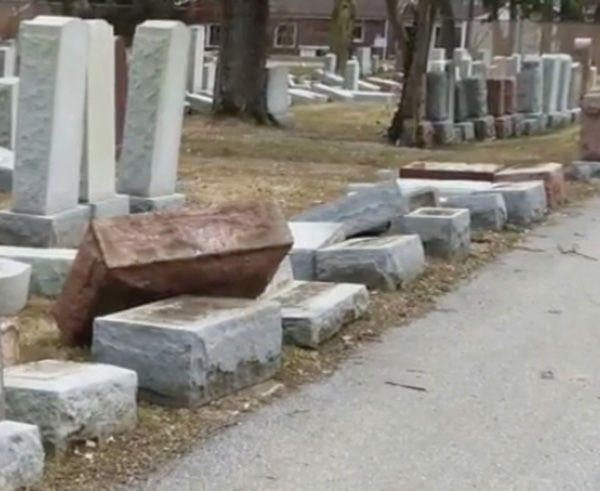Vicious Vandals
Published February 22, 2017
Never in recent memory has there been such community wide and even international revulsion over an incident like the savage desecration of the historic Chesed Shel Emeth Cemetery.
Even though it was not immediately clear whether the attack was anti-Semitism or mindless vandalism, many Jews in the St. Louis area have friends or family or both buried there, so the pain was strong no matter what the motivation.
Scores of gravestones were toppled at the cemetery on Hanley Road in University City — whose name includes the Hebrew word chesed, or “lovingkindness.” No suspects were arrested in the aftermath of the vandalism, and authorities were unsure whether it was an attack on Jews or a random act. But the images of Jewish burial monuments lying on the ground, some of them broken, evokes fear as well as the deepest kind of revulsion.
ADVERTISEMENT
And the desecration came against a backdrop of false bomb threats against many Jewish Community Centers nationwide, including the one here. On Monday, as St. Louisans were reeling from the news of the cemetery attack, centers in nearly a dozen cities were the targets of new bomb scares, from New York to New Mexico, from Minnesota to Alabama.
The public’s response in the wake of the cemetery vandalism has been heartening. Locally, people have stepped up not only to denounce what happened but to pledge support to repair the damage. Nationally, leaders have called for greater vigilance and greater understanding in a time of increased trouble.
Gov. Eric Greitens, Missouri’s first Jewish chief executive, called the vandalism a “despicable act,” adding:
“Anyone who would seek to divide us through an act of desecration will find instead that they unite us in shared determination. From their pitiful act of ugliness, we can emerge even more powerful in our faith.”
ADVERTISEMENT
Mufti Asif Umar of the Islamic Foundation of Greater St. Louis said that “no faith group deserves to go through this. We strongly condemn these acts and if there is anything our community or I can do, please let us know.”
President Donald Trump was slow to respond, leaving initial reaction to tweets by his daughter Ivanka and a statement released by the White House. Both talked of religious tolerance and individual freedom. But just as the administration’s statement commemorating the Holocaust managed to avoid mentioning Jews, neither was specific about the apparent target of the attack.
On Tuesday morning, as he toured the National Museum of African American History and Culture in Washington, the president spoke up, saying:
“Anti-Semitism is horrible and it’s going to stop, and it has to stop.”
Asked by a reporter if his statement meant he was denouncing anti-Semitism “once and for all,” Trump replied: “Of course, and I do it whenever I get the chance to do it.”
He didn’t do it last week, when he had the chance during his news conference. Dismissing a question about anti-Semitism as unfair and unexpected, he instead made the issue about him, saying “Number one, I am the least anti-Semitic person that you’ve ever seen in your entire life. Number two, racism, the least racist person.”
Then he reverted to familiar themes, his success in the election and his hatred of the media.
Such evasions are no longer adequate. While law enforcement authorities continue to investigate the cemetery incident and find out the cause, the toxic atmosphere in which it occurred still needs to be dealt with.
Someone who helped create the climate in which the cemetery attack and other moves against minorities are occurring has the responsibility to frequently, forcefully and unequivocally denounce such acts and the people who commit them. Until the president takes the lead in combatting prejudice in all of its forms, including anti-Semitism, statements by lower-ranking functionaries in the administration ring hollow.
It’s not enough for him to merely mention his Jewish daughter, son-in-law and grandchildren. The 60,000 Jews of St. Louis and the 5.2 million Jews of America deserve no less than the full-throated and sincere support of the president of the United States.
















